by admin | Feb 25, 2016 | Artist Resource, Inspiration, Uncategorized
Just the other day, as I was helping a student she said, “I just suck at this.” Believe it or not but this kind of talk is very common for young artists. Maybe you have even said something like it yourself. My response to this was “You don’t suck. You’re just learning!” I don’t know if that got through to her or not but it made me think. And sometimes when I get thinking, it turns into a blog post. So here it is.
Not too long ago I had a frustrated student say “Some people just have a lot of natural…” At this point I thought he was going to finish by saying “Natural talent and, I’m not one of them” (The myth of natural talent coming in a future blog post) But that is not what he said. He said, “Natural suckage, and I am one of them”. I was shocked! Did this student actually believe that there was such a thing as “Natural Suckage”? To my surprise there were some other students in the room who started agreeing with him. Natural Suckage! Really? I knew that there was a problem with negative talk among some of my students but this is when I realized how big the problem really was. These students were not just saying this out of frustration but deep down they really believed it. Because what I do is very skill based I hear these kinds of things a lot. I am sure that it is not just in my art class either. I am sure people are saying these types of things no matter what skill they are learning whether it is Art, Music, Math, Cooking, Soccer, or anything else that requires you to work hard to learn a specific skill. Not being very skilled at something isn’t the problem. The problem comes when you believe that you can’t learn a skill simply because you suck.
This goes beyond just thinking that you aren’t any good at something. It is the belief that you can’t get better. I recently had a student who was taking his turn on the pottery wheel. Because of my class size, the amount of classes in the semester and the limited number of pottery wheels we have in the classroom each student only gets two days on the wheel. Because it is so short of a time and not nearly enough time to really learn how to throw on the wheel I expect my students to make the most of those two days and spend the entire class working. After about 30 minutes into the first day this student stormed off in frustration. He threw his hands in the air and said “I can’t do this, It’s too hard” my immediate response was “Well… you have to try” still frustrated he snaps back “I did try. I tried three times and I couldn’t get the clay centered.” I will admit, I may not have handled the situation the best because all I could do was laugh and say “Three times! Try 300!” he didn’t think it was very funny but the point still stands. Anything worth doing is going to require work and trying something three times is hardly trying at all. Needless to say this student never got back on the wheel.
These students have what I will call “Imagined Natural Suckage” As I explained before, there is no such thing as natural suckage.
So now that we have identified the problem, how do we go about changing a long ingrained belief system in my students, or in myself, or you for that matter? It is something that I have spent many hours pondering and trying to help my students overcome.
Here are a few ways that I have found to overcome the feeling of “Imaginary Natural Suckage”. These point’s don’t only apply to learning art but they can apply to anything you are trying to get better at, whether it is artistic, sports, parenting, music, math, writing, etc.
#1 Stop comparing yourself to others
There will always be someone better then you at something. You will never be the best at everything. The point is to be the best that you can be and eventually, if you work really hard, you might get to the point where you actually are the best at something. Of course when you are to that point you most likely won’t even think you are because you will see how much better you want to be. I see students all the time who will take their first art class and immediately start comparing themselves to the students who have been drawing there whole life. If you have ever done this you are being unfair to yourself. Stop now. You be you, and try your hardest, and that will always be good enough.
#2 Commit to practicing
Getting good at something takes time. When I told my student “try 300” I wasn’t exaggerating. In fact go further… try 3,000. I can guarantee your 3,000th pot will be better than your 300th. If you are learning a new instrument give yourselves 5 years. Then see how well you can play. Anybody who has dedicated a significant amount of time to an instrument will tell you that the first year of playing is barely scratching the surface of your potential. How many of us quite after the first month? Apathy is a killer. Some people will say they just don’t care about anything enough to commit that much time and effort to it. Well… you need to start somewhere. Find something you enjoy doing and in the process of practicing and years of working at your skill you will become passionate about it.
#3 Stop the negative self talk
Your words influence your beliefs and your beliefs influence your words. If you are not careful it is a never ending spiral downward till you are drowning in negativity. You need to make a conscious effort to stop negative self talk. And if you ever find yourself saying that you stink at something you need to counteract it with saying something positive. Turn what you said negative around and say something positive. This might seem silly but it is important. Some people who aren’t experienced with positive affirmations will think it is silly because they don’t do it right. They will turn the negative “I suck at drawing” into “I am the best drawer ever!” Do they believe this? Of course not! And as they are saying it they know they are lying to themselves. The goal is not to lie to yourself but to positively build yourself up with something that you can actually believe. Turn “I suck at drawing” into “I can work hard to get better at drawing.” See… much more believable. Don’t turn “This is hard” into “this is easy” because it’s not. Instead turn “This is hard” into “I can do hard things”
My wife likes to ask herself questions instead of statements. If she ever finds herself being negative about something like getting our kids to help around the house, she won’t say “I’m so frustrated! These kids never help with anything!” Instead she asks “How do I get these kids to clean up so well?” When you ask yourself questions your mind will work overtime, even subconsciously to help you come up with a solution. This can be a very powerful kind of positive affirmation.

#4 Meditate
A big part of the problem is anxiety. I see people get anxious about all sorts of things. In my classroom I see students get nervous and frustrated after they have made one line on a piece of paper. That line might have taken them 10 minutes to finally build up the courage to draw and now they feel like their line doesn’t look good enough and when I walk around near them they immediately cover up their paper so I can’t see their “Imaginary Suckage”. These students have Anxiety.
If we think in terms of energy, Anxiety is when our energy is dispersed and we have many problems going on in our minds and hearts that our energy is trying to fix and worry about. Often times those problems are also imaginary but to an anxious person imagined or not, the problems still feel the same. When we are anxious we are worried about multiple things while trying to concentrate on another and then wondering what might happen when, or if, something else happens, none of which you seem to have any control over which makes you more anxious. Our energy is not being productive because it is trying to do too many things at once. And, in the end whatever you were trying to do ends up failing. Then our “Imaginary Natural Suckage” has been confirmed and our belief becomes even more ingrained.
Meditation is a great way to overcome anxiety. There are many purposes and benefits to meditation but in this case what we are trying to do is focus our energy and apply it to the task at hand. This is not a blog post about various methods of mediation, so I will not go into detail on ways to meditate but I encourage you to research methods yourself. Maybe that would be a good topic for another blog post. I will often teach my students a few meditation techniques to help with anxiety. There are always some who think it’s silly but a good amount of my students love it. Every once in a while I will catch one of my students sitting there in the position I taught them with their eyes closed and breathing slowly. These students are tuning everything out around them and focusing their energy to their artwork. Once they are finished they get to work. And guess what. When they aren’t anxious they do great work that they are proud of.
So I repeat… You don’t suck. You are just learning!
I hope these point’s are able to help you in some aspect of your life. Do you have any other things that have helped you overcome the feelings of “Natural Suckage”? If you do, let me know in the comments below. If you think this post could help someone else please share it with them.

by admin | Sep 24, 2015 | Uncategorized
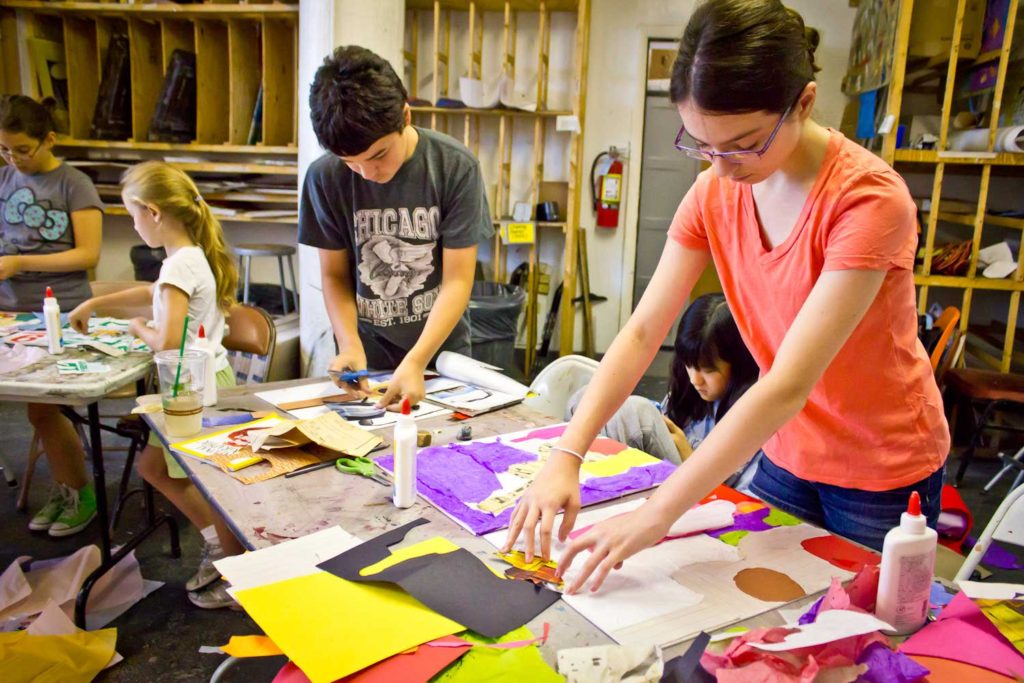
Image from lillstreet.com
�
I was recently interviewed by a woman taking an Art Education class at a local college. Although I don’t remember the specific questions that were asked the general idea of most of the questions were “why is art important in our schools?” Honestly this is a question that I have struggled to answer ever since I have become a teacher. It is a topic that has spawned a lot of national debate and may school districts have cut their art programs. I have always felt like it was important but I just had a hard time explaining why. I don’t get asked this question very often so I have never had to put it into words like I did during this interview. I think I was able to explain myself pretty well but now that I have had a few days to think it over I want to explain a few reasons to you why art is so important for our schools. For the sake of this post when I say art I am often talking about the Arts in general including music, theater, and dance.
Art deals with the aesthetic experience
As defined by Sir Ken Robinson in his speech Changing Education Paradigms, an “aesthetic experience is one in which your senses are operating at their peak, when you’re present in the current moment, when you’re resonating with the excitement of this thing that you’re experiencing, when you’re fully alive.” And the Arts are the classes that focus on these experiences.
An Aesthetic Experience is when you are so taken with the beauty of an object, Idea, situation, or simply life itself that the only real words to explain it are “Wow!” People often have aesthetic experiences when they listen to music, experience nature, view artwork, are fascinated by the details of life, have an epiphany, read a good book, and many other instances. Really you can have an aesthetic experience anywhere and at any time. Even in school but especially in art.
In my opinion aesthetic experiences are what make life worth living. Now don’t get me wrong, I am not saying that it is not possible to have an aesthetic experience in other classes, but those other classes are not focused on those experiences like Art is. How often does a math teacher talk about the way an equation makes you feel? Or how often does an anatomy teacher teach about how beautifully the human body is proportioned and how similar we are yet different all at the same time? Art teaches students to recognize when you are having an aesthetic experience, and the more you recognize it the more often they occur and the fuller life you live.
Art teaches creativity
Every teacher in every school struggles to incorporate creative thinking into their subjects. Creativity is a skill that is diminishing drastically as the years go by. There are many reasons for this drop in creativity. Some will blame it on electronic devices, television, non creative toys, helicopter parenting, and even the schooling system. In reality it is probably a combination of these and other factors.
There is no better place to teach creativity in schools than the Art classroom. It is not that other teachers can’t teach about creativity as it applies to their subject, but all too often they don’t. There is a common myth that people think they are unable to learn creativity. And if they don’t have it then they don’t have it. This is a lie but many people believe it anyway. If I were to ask teachers in my school if they were creative I am confident a majority would say no. As an Art teacher I have taken it upon myself to teach creativity. In no other classroom in the school is creativity so encouraged and accepted. Simply put, Art Teaches creativity like no other subject can, and creativity is a skill that can and should be applied to every aspect of life.
Art teaches about visual culture.
In today’s world we are constantly bombarded with visual stimuli. Everywhere we go there are advertisements screaming at you, videos, graphic design, fashion, and many other visual things vying for your attention. Art class is the only class that attempts to scratch the surface of educating students on visual culture. With visual culture so much a part of our lives it would be ridiculous to think we don’t need some sort of a visual education.
Art gives other subjects application
I was just telling my wife last night how I am very into Anatomy and learning the muscles and bones, but if it wasn’t for my interest in art I don’t think I would care about anatomy at all. For students who have an interest in art there are many parallels that can be drawn from other subjects. Correlations include math as we practice proportions and perspective drawing. Science as we mix glazes and paint. Anatomy as we learn how to draw and sculpt the human body. Literature as we are inspired by poetry and other works. History as we learn about artist and artist movements in history.
Art gives an outlet for many students who are not interested in other things.
In a quick informal survey of my students I asked “why is it important to have art in school” they didn’t need time to think about it, they immediately blurted out reasons it is important to them. Some said things like “because it teaches us how to express ourselves better” others said things like “it gives us a relaxing break from boring classes”. This was an advanced class full of kids who enjoyed art. For many of these students art is the reason why they come to school. It was much the same for me. I really struggled in school growing up and art was the only class I felt I belonged. It was the only class that kept me going to school. Some might argue that there are other ways to give students an outlet, and they are right. There are extracurricular sports, cooking, agriculture classes. all of which can fill that same roll. However there are still students who have a need and thirst for the arts and those other classes simply will not do.
This by no means is an extensive list of reasons why art is important in schools but I think they are some pretty solid reasons. I’d like to know what you think. What are some reasons you think art is important to schools… or not. I’d love to hear your comments.
by admin | Sep 18, 2015 | Uncategorized
The Shelley City Council accepted my proposal for my bust of John F. Shelley to go in City Hall. This week I finished him up, and Hollowed him out. Here is a picture of me doing that.
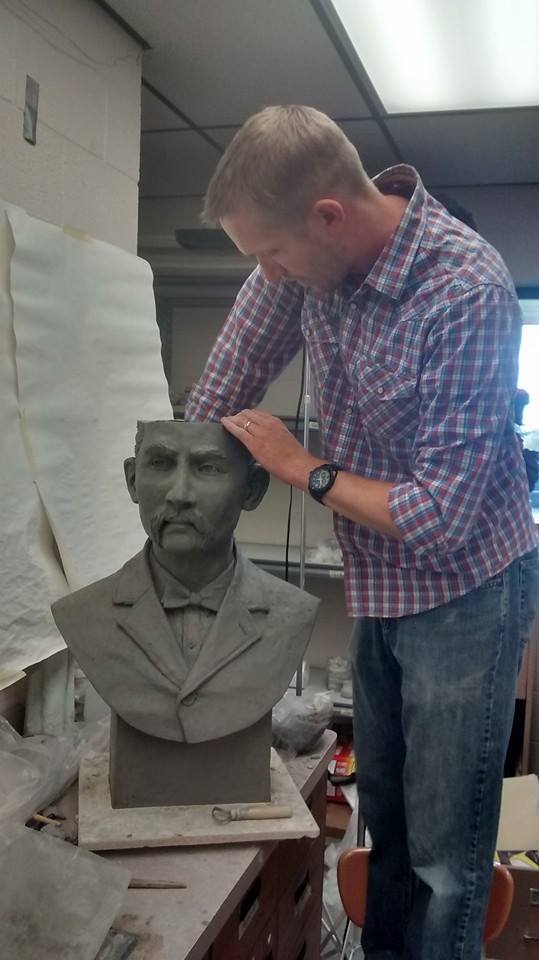
If you are unaware about how firing a water based clay sculpture works allow me to explain. First of all you need to make the sculpture. I do this using an armature (which for this case is really just a metal pipe and a ball of paper). The armature is what keeps the clay up. Once the sculpture is done you can’t just put it in the kiln and fire it. First it needs to be hollowed out. There are a few reasons you do this. For one it makes it not nearly as heavy. This sculpture required about 150 pounds of clay to make and when it was hollowed out it was around 75 pounds. It will be even lighter after it is dried and fired. Hollowing out also helps your sculpture not explode in the kiln. The moisture in the clay comes out in the kiln and if the clay is too thick it has a hard time coming out and starts exploding.
You can see from the picture that I cut off the top of the head to do this hollowing. I also laid him down on a pillow and hollowed from the bottom as well.
Now that this sculpture is finished and drying I am able to work again on my little girl praying. Coming back to it with fresh eyes made me see a lot of things I needed to finish, fix, and change. This is a work in progress but it is coming along.
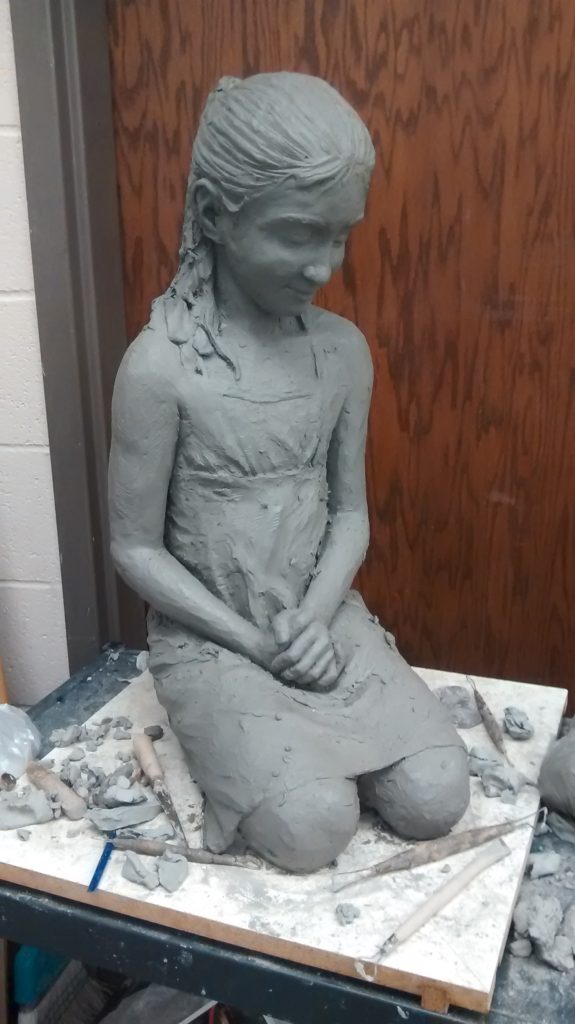
I also received some exciting news. I told you before on this blog that my sculpture Out on the Town was not accepted by the Meridian Arts Commission. Well I recently found out that the chose another sculpture for the location they had planned but they are currently discussing funding and placement options for my sculpture as well. They liked it a lot but felt that it would be better in a place that received less vehicular traffic and more pedestrian traffic. It is not for certain yet but hopefully I will be creating this sculpture for Meridian after all.

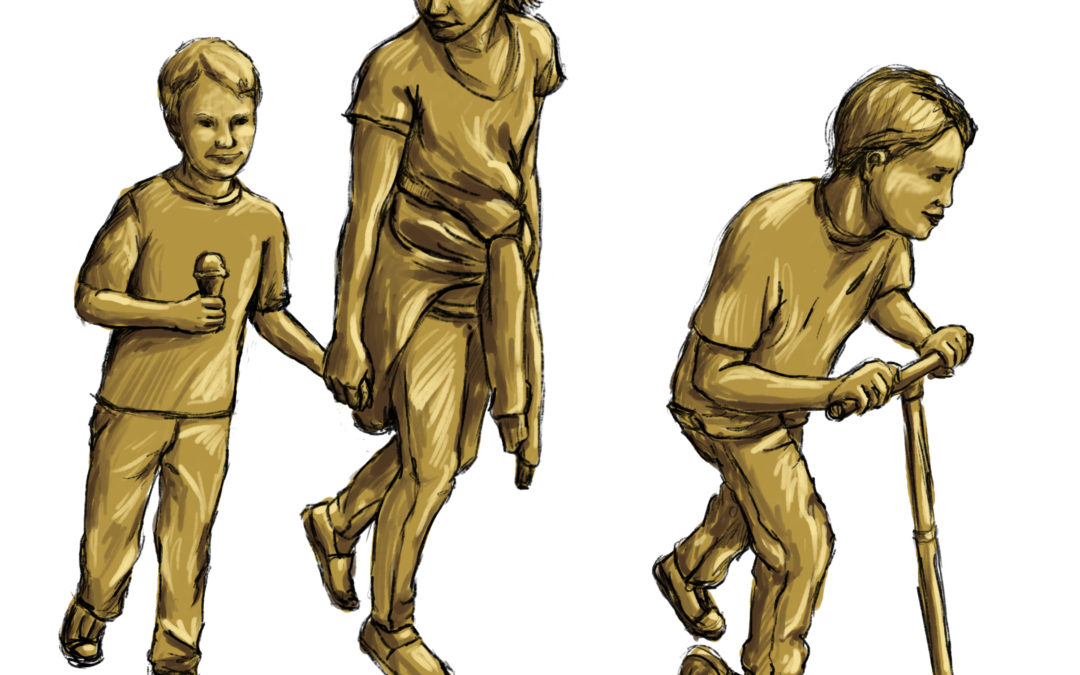
by admin | Jun 22, 2015 | Artist weekly Log, Uncategorized
It has been a busy summer both artistically and otherwise. I have not written a post in a number of weeks an as such have so much to say I hardly know where to start. This blog post will be a quick recap of the past few weeks and I will also tell you about a couple things you can do to get involved with my artwork.

The picture above is a design I created for a sculpture I would like to make for my hometown Meridian Idaho. I was chosen as a finalist for this project and they are accepting public input both at Meridian City Hall and online. I invite you to read the proposals and if you feel so inclined to write in a letter in support of my sculpture design. Here is an excerpt from my proposal to the Meridian Arts Council
“My sculpture design features three children enjoying a day out on the town. I have many good memories of going into downtown Meridian with my older siblings, buying candy at Albertsons, Hamburgers and Ice cream at the Burger Den (which is now Main Street Burger), and then looking at toys at Payless (which is now Rite Aid). Coincidentally the location for this project is in the center of these stores. In a way this is a portrait of us when we were younger. I am the little boy with the Ice cream cone holding my older sisters hand and my older brother going ahead of us with a box of candy in his back pocket. I hope it can inspire the people and children in Meridian to enjoy the town more, and help make this corner a little more inviting.”
I hope you will support me in this. Click here to see all the proposals and support my design.
I have also been doing a lot of work trying to get ready for the Jackson Hole Art Fair which I will be selling my work in. You are also invited to come and see me at my booth on July 10th, 11th, and 12th in Jackson Hole. It will be a ton of fun with lots of great artwork from many great artists! You can read more about the Jackson Hole Art Fair here.
Here are a few of the things I have been working on.
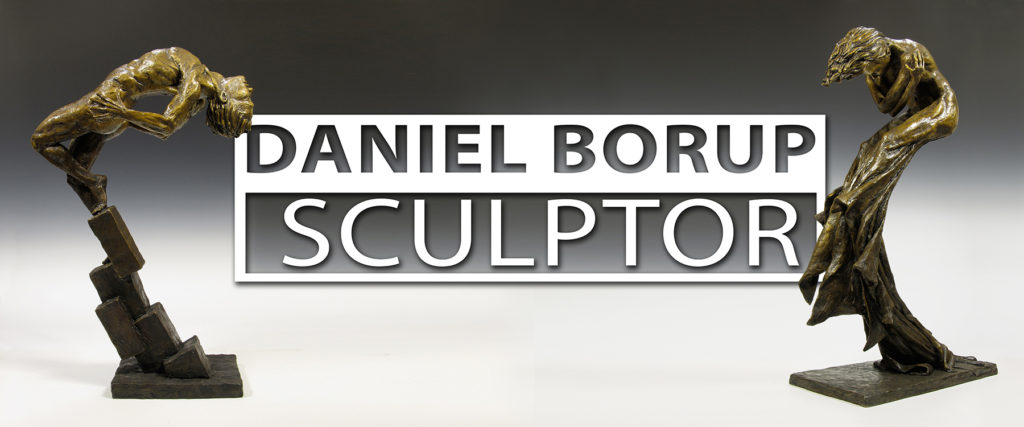
Made this totally awesome banner for my booth!
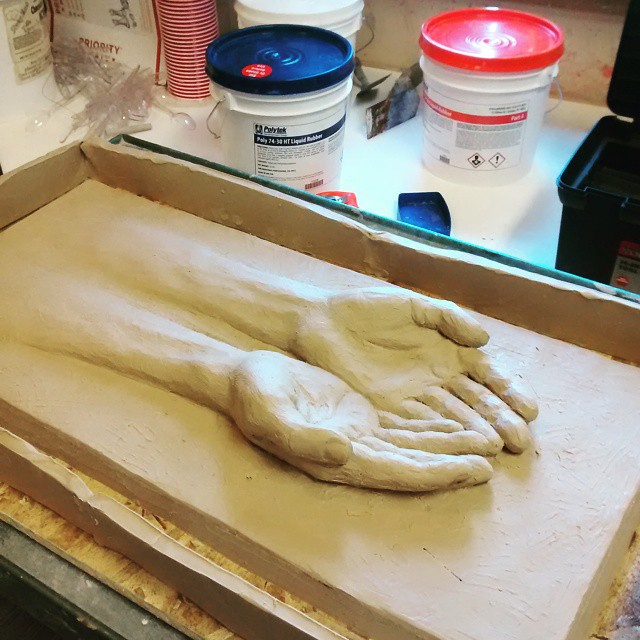
Made a mold for this sculpture of hands entitled “Blessings”
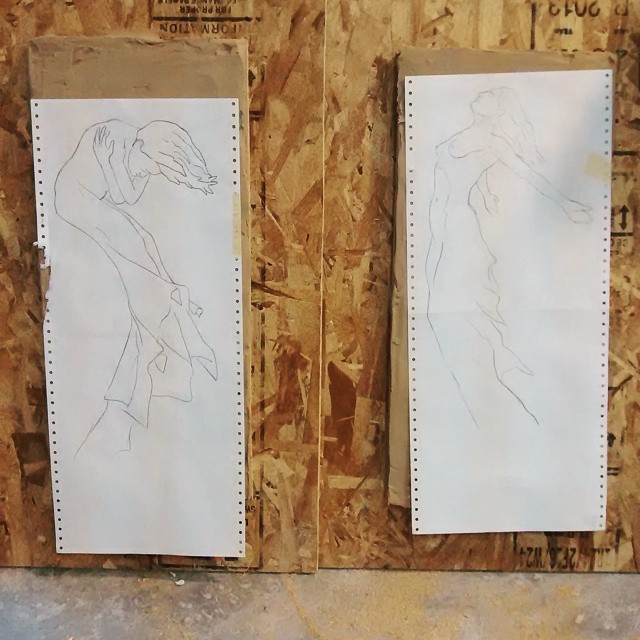
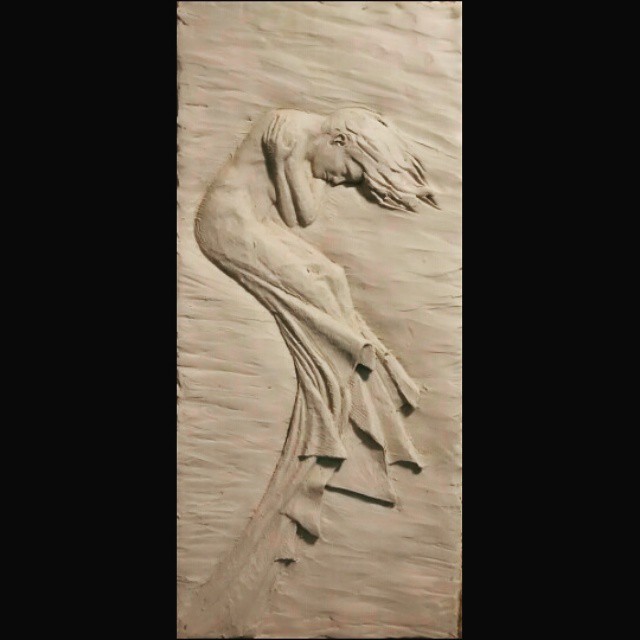
Started Sculpting the relief versions of my full round sculptures “Shelter” and “Lotus”
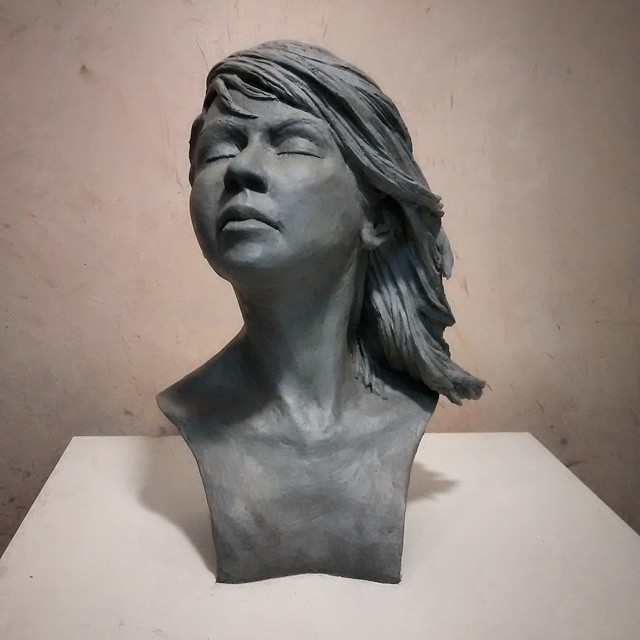
Finished this sculpture entitled “Stormy Day”
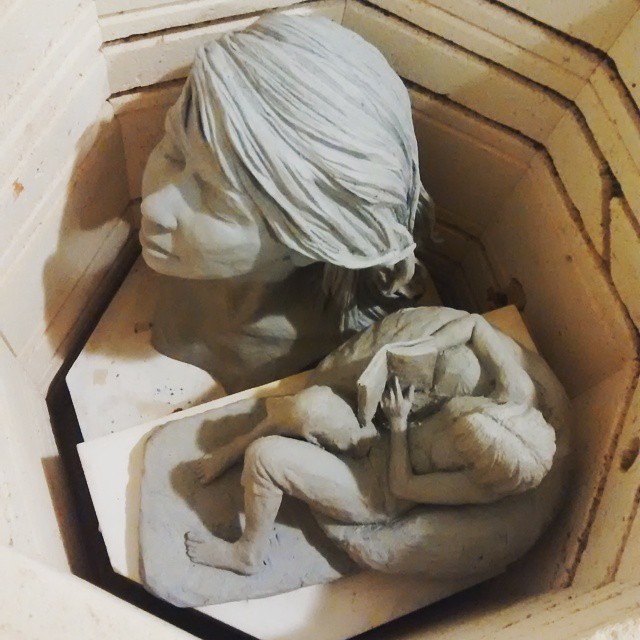
Fired the Kiln with my new sculptures in it.
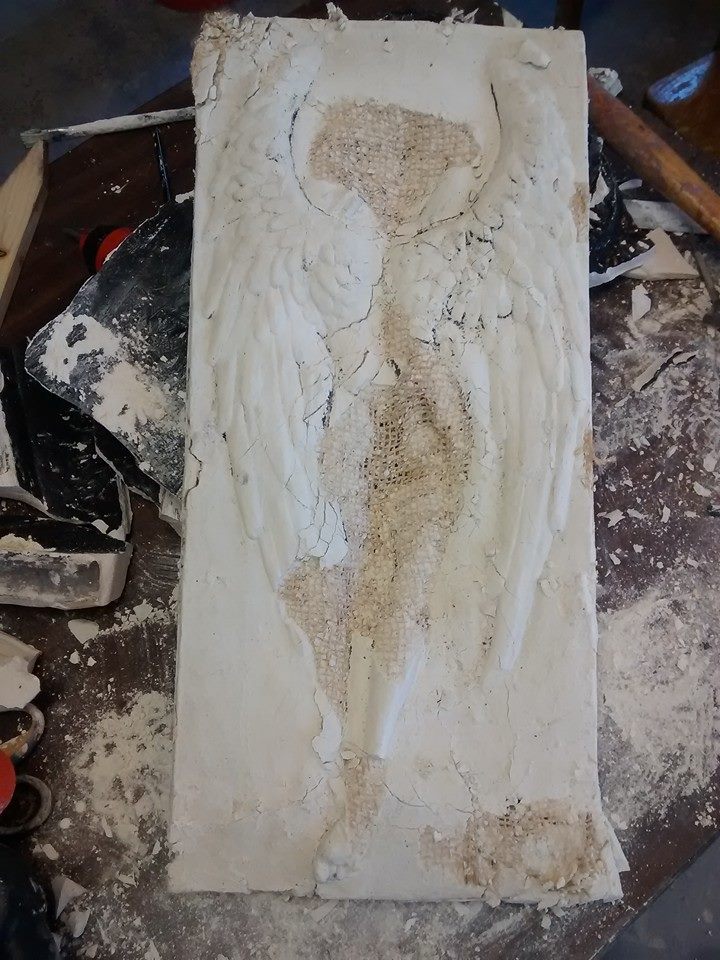
Completely destroyed the first casting and the mold for this sculpture. No worries I still had the orginal which I am making a new mold of.
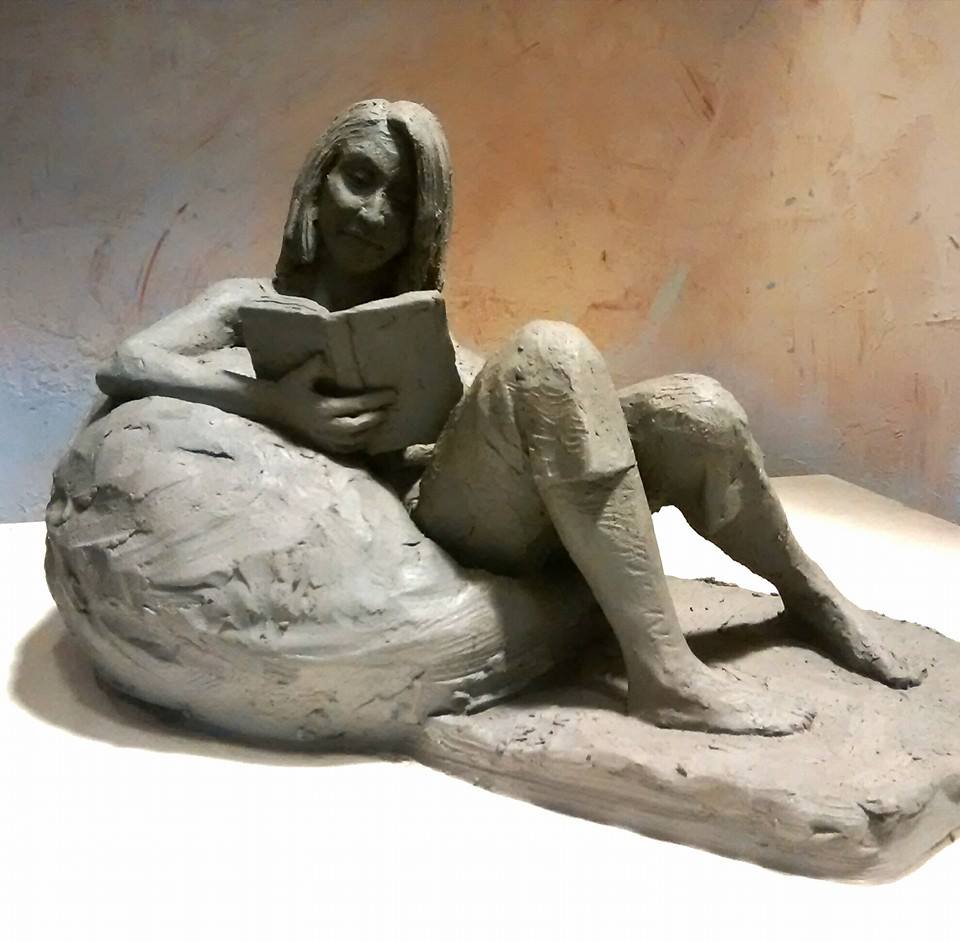
Finished this sculpture which the title is still up for debate.
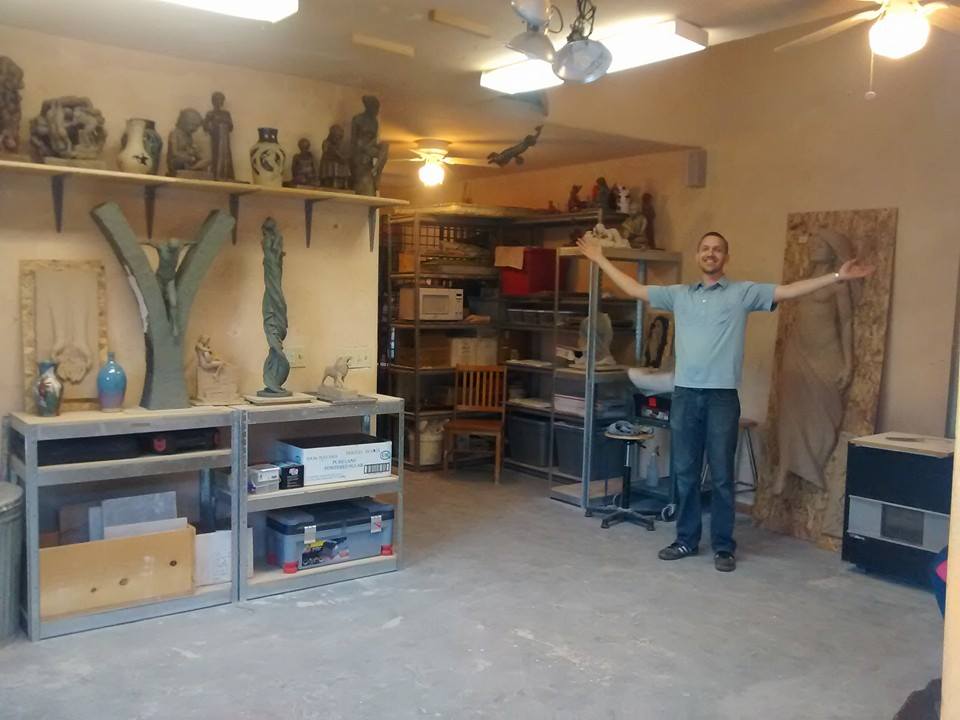
And I cleaned and organized my awesome studio. You can see more pics of my studio if you click here.
More has happened but I have work to do! You will just have to hear about it in future blog posts.

by admin | May 14, 2015 | Artist Resource, Creative Process, Inspiration, Uncategorized
The other day one of my students asked me what I do when I get “Artist Block”. I quickly responded “Artist Block? It doesn’t exist!”. This student disagreed as well as other students in the area who were listening to the conversation. “Yes it does.” One would say “I never know what to draw!” said another.

I listened to their arguments and though about it for a little. I realized that what my students were thinking was that you need to have some grand idea before you can get to work making art. And in my experience it is quite the opposite. Ideas rarely come from sitting there trying to think of ideas. Ideas come while you are hard at work.
I responded to my students “I never experience artist block because I am willing to get to work without any ideas.” Some my respond to this with “But what if what we draw looks stupid?” To that I say who cares? As an artist you need to be willing to create and it is possible you will make stupid looking drawings. You won’t learn otherwise. Everyone needs to start somewhere. And I will let you in on a little secret. The better you get the more you realize how much you have to learn. Something I love about art is I feel like I can sculpt my whole life and still have more to learn.
The conversation when on, but the gist of it was that if you are waiting for something brilliant to draw before you start drawing you will always have artist block. If you are willing to draw anything at anytime no matter what it is going to look like you will feel that artist block doesn’t exist. And it won’t! Not for you anyway.
This seems like common knowledge to me but the more I teach the more I realize this is a foreign concept to many people including may artists. However I know that I am right on this topic and I have a few very well know artists backing me up so I am also in good company.
Pablo Picasso said “Inspiration exists, but it has to find us working.” Doesn’t that sound a lot like what I was just telling my students? Artist Chuck Close put it another way, he said, “Inspiration is highly overrated. If you sit around and wait for the clouds to part, it’s not liable to ever happen. More often than not, work is salvation.” He also said, “I don’t work with inspiration. Inspiration is for amateurs. I just get to work.”
There is a story one of my artist friends likes to tell me. He was once in Jackson Hole Wyoming visiting an art show. At this particular show Artists were participating in an event called a quick draw. Basically artists are given 3 hours to draw or paint whatever they want. People walk around and see the artwork being made and in the end they auction off all the artwork. Toward the end my friend was walking around seeing a bunch of wonderful artwork being made. He came across an artist who had painted a canvas with a few dots and was now sitting on the ground cross legged and meditating to get inspiration on what she should do next on her painting. That’s it! After three hours all she had was a few dots! Now who do you think were the artists receiving inspiration that day? The artists who got to work, or the ones who sat on the ground waiting for inspiration? Now I’m not saying that meditation is a bad thing. On the contrary it can be a great way to clear your mind and get you ready to work. But that is just it. It has to be followed by work.
I try to teach my students that when they are working on one project they should be coming up with Ideas for their next project. This is the way I work and I have more ideas than I know what to do with. In fact, I get so excited about my ideas that often start another project before I am done with one. I currently have six sculptures that I have started but aren’t finished, and that doesn’t include a few paintings I have also started. Will I finish them? Sure I will! I enjoy having multiple things to work on so I can switch back and forth whenever I choose. Some of my students catch on to this and end up doing the same. One of my students who will be graduating on Tuesday once said to me “it’s funny but all of my best ideas come to me when I am working on another project.” and likewise she has so many ideas she barely has time to finish them.
So now the question is, what do I mean when I say to draw anything? I mean anything. I often will pull up figure drawing videos and draw from those. You can read a post about this here. I also show my students creativity building activities like doing a squiggle drawing or a back and forth drawing. Draw your hand, draw your shoe, draw the items in your pocket.
Too many people shoot their ideas down before they have had time to develop them. Here is a quote from me that I often tell my students:
“There are no bad ideas in art. Just ideas that you have not spent time developing”
-Daniel Borup
I like this quote and I think it is true. All to often when a student says “I have no ideas” what they are really saying is “none of my ideas are very good.” Good ideas rarely come in an instant. They start small and you build upon them. Overtime if you develop it in the right way it might become something that will affect the emotions and lives of many. If not that is okay because there are an infinite amount of ideas to come and take its place. The point is the time and effort you put into your ideas. In one blog post I detailed some of my creative process of a sculpture I am still working on, which you can find here.
I will leave you with one more quote from Andy Warhol.
“Don’t think about making art, just get it done. Let everyone else decide whether it’s good or bad, whether they love it or hate it. While they are deciding, make even more art.”
-Andy Warhol
What do you think? Have you ever had “Artist Block”? What are some ways you have overcome a creative block? Let me know. I appreciate your comments.
by admin | Apr 17, 2015 | Uncategorized

It has been a little over a year since I sculpted Shelter. This sculpture was a bit of a breakthrough for me. I knew I wanted to be a figure sculptor but at this point I was still trying to figure out what I wanted to do and say with my art. There is nothing wrong with sculpting something simply because it is beautiful. There are many artists who do wonderful work that do just that. However, I wanted to do something more. I wanted my work to mean something and to say something, yet up until this point my work didn’t really say much at all. It was beautiful work! But didn’t say much.
The concept for Shelter came because I wanted to say something. I wanted to portray an emotion. I wanted to sculpt part of myself into my work. And because I did those things, people connected with my work on a deeper level than ever before.
Here is the first image of Shelter which I first posted to facebook.
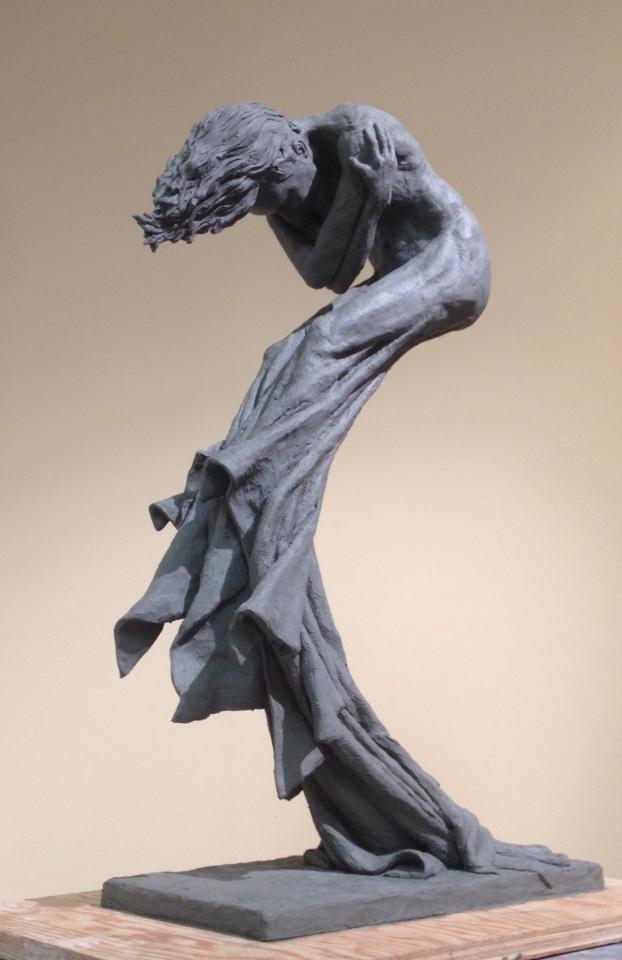
Shelter portrays a strong woman in the midst of a storm. She is bearing through the storm that rages on behind her. Hunching over and learning to shield (or Shelter) herself from the storm.
I chose to show her elevated to represent her ability to rise above the storm and overcoming her trials.
This concept comes from some women in my life who were metaphorically in their own storm. I see these women learning and growing stronger from their trials and although they will never be the same when the storm subsides that is not necessarily a bad thing.
I love this sculpture because it speaks to me. I feel something every time I see it. It motivates me to persist a little longer, and bear through my own storms (although small) and grow from them.
I hope that you can be inspired by this work also. To not only see the things that I do but to see more. To feel the sculpture talking to you and helping you through your personal storms.
Recently I had this sculpture cast in bronze. The limited edition of 19 is available to purchase on my website at this link.
This sculpture was just the start. I have made many sculptures since then that depict different emotions and each have their own story. I hope you will get involved with my artwork. If you are able to purchase the artwork great. If not, please follow along with my progress as an artist and hear the stories behind my pieces.
What do you think. What does Shelter say to you?



















